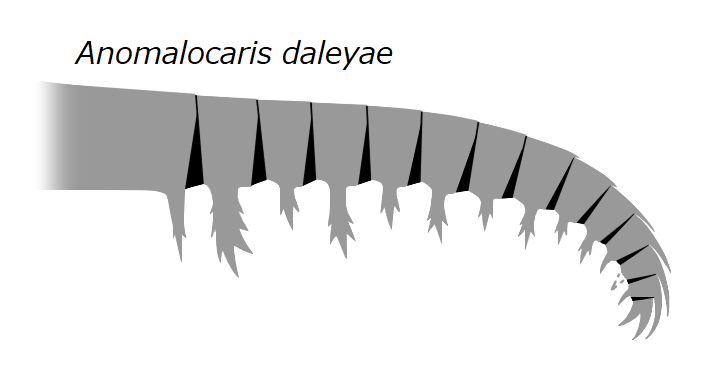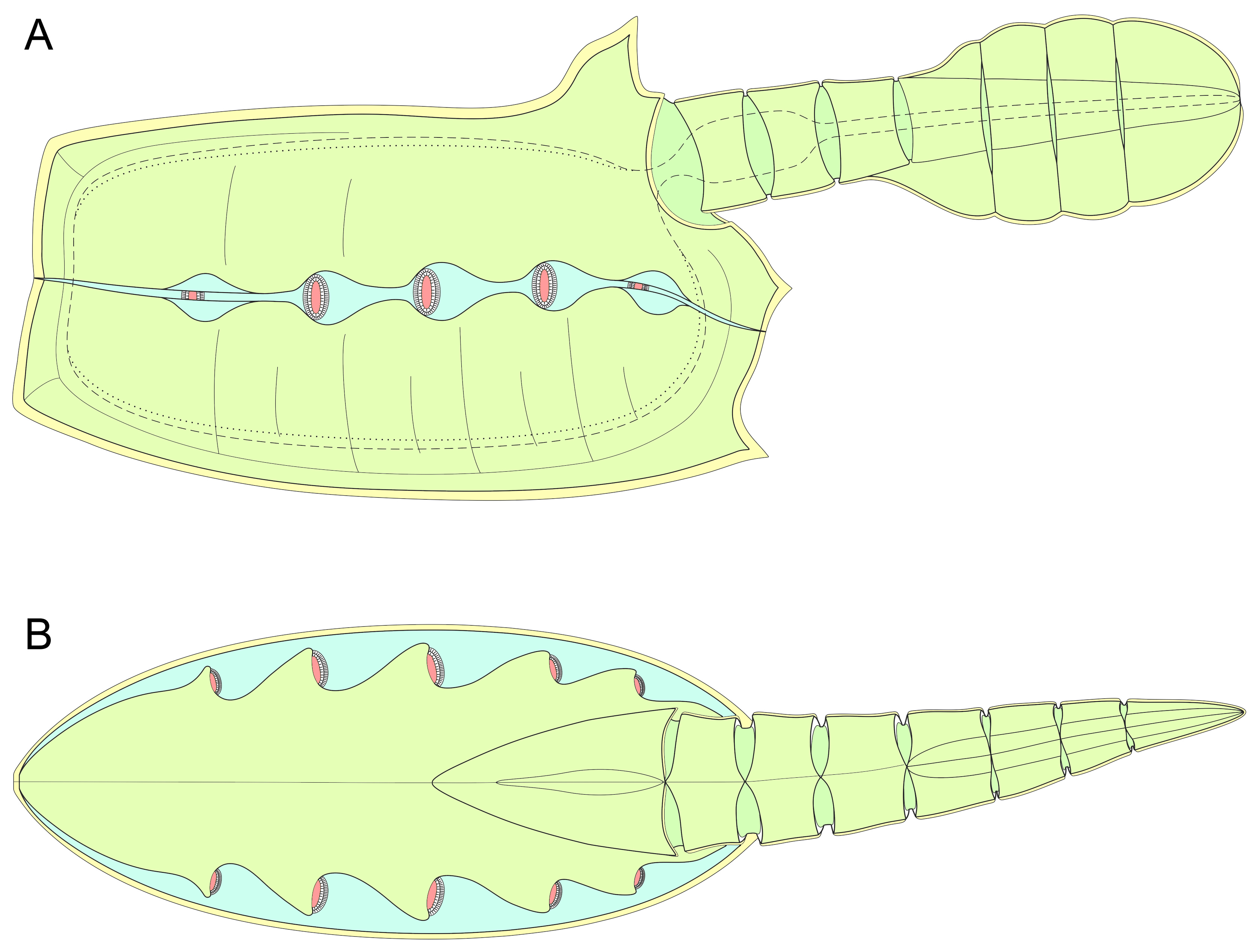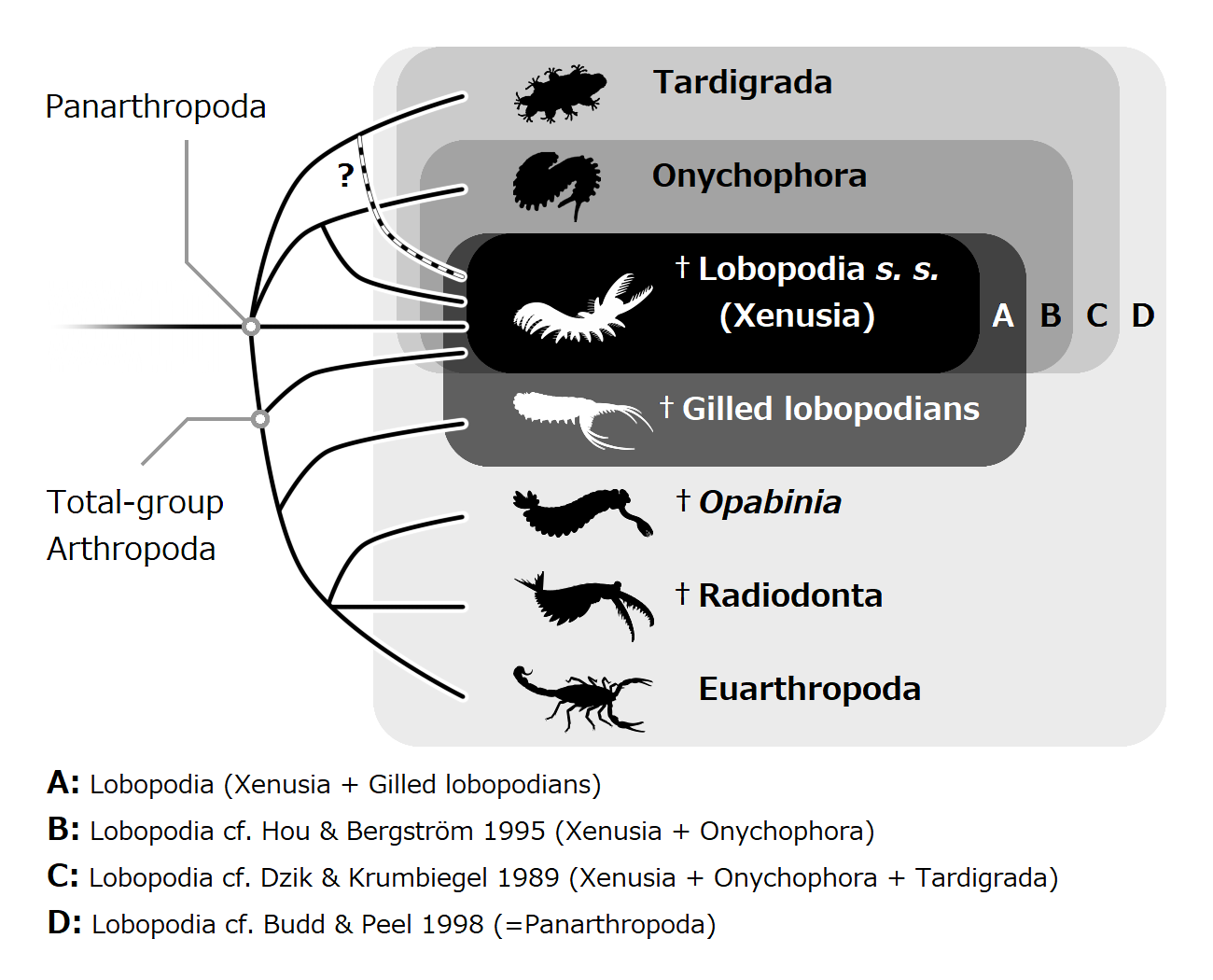|
Emu Bay Shales
The Emu Bay Shale is a geological formation in Emu Bay, South Australia, containing a major Konservat-Lagerstätte (fossil beds with soft tissue preservation). It is one of two in the world containing Redlichiidan trilobites. The Emu Bay Shale is dated as Cambrian Series 2, Stage 4, correlated with the upper Botomian Stage of the Lower Cambrian. Its mode of preservation is the same as the Burgess shale, but the larger grain size of the Emu Bay rock means that the quality of preservation is lower. More than 50 species of trilobites, non-biomineralized arthropods (including megacheirans, nektaspids, and hymenocarines), radiodonts, palaeoscolecids, a lobopodian, a polychaete, vetulicolians, nectocaridids, hyoliths, brachiopods, sponges, chancelloriids, several problematica and a chelicerate are known from the Emu Bay Shale. Description The Emu Bay Shale of Kangaroo Island, South Australia, is Australia's only known Burgess-Shale-type Konservat-Lagerstätte, and includes f ... [...More Info...] [...Related Items...] OR: [Wikipedia] [Google] [Baidu] |
Formation (stratigraphy)
A geological formation, or simply formation, is a body of rock having a consistent set of physical characteristics (lithology) that distinguishes it from adjacent bodies of rock, and which occupies a particular position in the layers of rock exposed in a geographical region (the stratigraphic column). It is the fundamental unit of lithostratigraphy, the study of strata or rock layers. A formation must be large enough that it can be mapped at the surface or traced in the subsurface. Formations are otherwise not defined by the thickness (geology), thickness of their rock strata, which can vary widely. They are usually, but not universally, tabular in form. They may consist of a single lithology (rock type), or of alternating beds of two or more lithologies, or even a heterogeneous mixture of lithologies, so long as this distinguishes them from adjacent bodies of rock. The concept of a geologic formation goes back to the beginnings of modern scientific geology. The term was used by ... [...More Info...] [...Related Items...] OR: [Wikipedia] [Google] [Baidu] |
Burgess Shale Type Preservation
The Burgess Shale of British Columbia is famous for its exceptional preservation of mid-Cambrian organisms. Around 69 other sites have been discovered of a similar age, with soft tissues preserved in a similar, though not identical, fashion. Additional sites with a similar form of preservation are known from the Ediacaran and Ordovician periods. These various shales are of great importance in the reconstruction of the ecosystems immediately after the Cambrian explosion. The taphonomic regime results in soft tissue being preserved, meaning that organisms without conventionally fossilized hard parts can be seen. This provides further insight into the organs of more familiar organisms such as the trilobites. The most famous localities preserving organisms in this fashion are the Canadian Burgess Shale, the Chinese Chengjiang fauna, and the more remote Sirius Passet in north Greenland. However, a number of other localities also exist. Distribution Burgess Shale-type biotas are foun ... [...More Info...] [...Related Items...] OR: [Wikipedia] [Google] [Baidu] |
Hyolitha
Hyoliths are animals with small conical surface, conical Exoskeleton, shells, known from fossils from the Palaeozoic era. They are at least considered as being lophotrochozoan, and possibly being lophophorates, a group which includes the brachiopods (hyoliths may even be brachiopods themselves), while others consider them as being basal lophotrochozoans, or even Mollusca, molluscs. Morphology The shell of a hyolith is typically one to four centimeters in length, triangular or elliptical in cross section. Some species have rings or stripes. It comprises two parts: the main conical shell (previously referred to as a ‘conch’) and a cap-like Operculum (animal), operculum. Some also had two curved supports known as ''helens'' They are calcium carbonate, calcareous – probably aragonitic All of these structures grew by marginal accretion. Shell microstructure The orthothecid shell has an internal layer with a microstructure of transverse bundles, and an external layer compri ... [...More Info...] [...Related Items...] OR: [Wikipedia] [Google] [Baidu] |
Nectocarididae
Nectocarididae is a controversial family of animals that superficially resemble squids. Only two genera have been described, being '' Nectocaris'' (=''Vetustovermis'', ''Petalilium''?) from the Cambrian period, and '' Nectocotis'', from the Ordovician The Ordovician ( ) is a geologic period and System (geology), system, the second of six periods of the Paleozoic Era (geology), Era, and the second of twelve periods of the Phanerozoic Eon (geology), Eon. The Ordovician spans 41.6 million years f ... period. Some researchers claim they are cephalopods, however, this is heavily disputed and most reject this claim. List of Genera *'' Nectocaris'' *'' Nectocotis'' *'' Vetustovermis''? synonym of Nectocaris *'' Petalilium''? synonym of Nectocaris References Cambrian life Taxa named by Simon Conway Morris Taxa described in 1976 Nectocarididae Prehistoric animal families {{cambrian-animal-stub ... [...More Info...] [...Related Items...] OR: [Wikipedia] [Google] [Baidu] |
Vetulicolia
Vetulicolia is a group of bilaterian marine animals encompassing several extinct species from the Cambrian, and possibly Ediacaran, periods. As of 2023, the majority of workers favor placing Vetulicolians in the stem group of the Chordata, but some continue to favor a more crownward placement as a sister group to the Tunicata. It was initially erected as a monophyletic clade with the rank of phylum in 2001, with subsequent work supporting its monophyly. However, more recent research suggests that vetulicolians may be paraphyletic and form a basal evolutionary grade of stem chordates. Etymology The taxon name, Vetulicolia, is derived from the type genus, '' Vetulicola'', which is a compound Latin word composed of ''vetuli'' "old" and ''cola'' "inhabitant". It was named after '' Vetulicola cuneata'', the first species of the group described in 1987. Description The vetulicolian body plan comprises two parts: a voluminous rostral (anterior) forebody, tipped with an anteri ... [...More Info...] [...Related Items...] OR: [Wikipedia] [Google] [Baidu] |
Polychaete
Polychaeta () is a paraphyletic class of generally marine Annelid, annelid worms, common name, commonly called bristle worms or polychaetes (). Each body segment has a pair of fleshy protrusions called parapodia that bear many bristles, called chaetae, which are made of chitin. More than 10,000 species are described in this class. Common representatives include the lugworm (''Arenicola marina'') and the Alitta virens, sandworm or Alitta succinea, clam worm ''Alitta''. Polychaetes as a class are robust and widespread, with species that live in the coldest ocean temperatures of the abyssal plain, to forms which tolerate the extremely high temperatures near hydrothermal vents. Polychaetes occur throughout the Earth's oceans at all depths, from forms that live as plankton near the surface, to a 2- to 3-cm specimen (still unclassified) observed by the robot ocean probe Nereus (underwater vehicle), ''Nereus'' at the bottom of the Challenger Deep, the deepest known spot in the Earth's ... [...More Info...] [...Related Items...] OR: [Wikipedia] [Google] [Baidu] |
Lobopodia
Lobopodians are members of the informal group Lobopodia (), or the formally erected phylum Lobopoda Cavalier-Smith (1998). They are panarthropods with stubby legs called lobopods, a term which may also be used as a common name of this group as well. While the definition of lobopodians may differ between literatures, it usually refers to a group of soft-bodied, marine worm-like fossil panarthropods such as '' Aysheaia'' and '' Hallucigenia''. However, other genera like '' Kerygmachela'' and '' Pambdelurion'' (which have features similar to other groups) are often referred to as “gilled lobopodians”. The oldest near-complete fossil lobopodians date to the Lower Cambrian; some are also known from Ordovician, Silurian and Carboniferous Lagerstätten. Some bear toughened claws, plates or spines, which are commonly preserved as carbonaceous or mineralized microfossils in Cambrian strata. The grouping is considered to be paraphyletic, as the three living panarthropod groups (A ... [...More Info...] [...Related Items...] OR: [Wikipedia] [Google] [Baidu] |
Palaeoscolecid
The palaeoscolecids are a group of extinct ecdysozoan worms resembling armoured priapulids. They are known from the Lower Cambrian to the lower Ludfordian (late Silurian); they are mainly found as disarticulated sclerites, but are also preserved in many of the Cambrian lagerstätten. They take their name from the typifying genus '' Palaeoscolex''. Other genera include '' Cricocosmia'' from the Lower Cambrian Chengjiang biota. Their taxonomic affinities within Ecdysozoa have been the subject of debate. Morphology Palaeoscolecids bear an annulated trunk ornamented with circular patterns of phosphatic tesselating plates; a layered cuticle; and an armoured proboscis. They are long and narrow, and can reach tens of centimetres in length. Their cuticle is annulated, typically in complete rings, but sometimes the rings split or only encircle part of the trunk. Each annulus is essentially identical to its neighbours; the only trunk differentiation is at the anterior and posterior ... [...More Info...] [...Related Items...] OR: [Wikipedia] [Google] [Baidu] |
Radiodonta
Radiodonta is an extinct Order (biology), order of stem-group arthropods that was successful worldwide during the Cambrian period. Radiodonts are distinguished by their distinctive frontal appendages, which are morphologically diverse and were used for a variety of functions. Radiodonts were among the earliest large predators, but they also included sediment sifters and filter feeders. Some of the most famous species of radiodonts are the Cambrian taxa ''Anomalocaris, Anomalocaris canadensis'', ''Hurdia, Hurdia victoria'', ''Peytoia nathorsti'', ''Titanokorys gainesii, Titanokorys gainesi, Cambroraster, Cambroraster falcatus'' and ''Amplectobelua, Amplectobelua symbrachiata''. The later surviving members include the subfamily Aegirocassisinae from the Early Ordovician of Morocco and the Early Devonian member ''Schinderhannes bartelsi'' from Germany. Etymology The name Radiodonta (Latin for ''radius'' "spoke of a wheel" and Greek for ''odoús'' "tooth") refers to the radial arrang ... [...More Info...] [...Related Items...] OR: [Wikipedia] [Google] [Baidu] |
Hymenocarina
Hymenocarina is an Order (biology), order of extinct marine arthropods known from the Cambrian. They possess bivalved carapaces, typically with exposed posteriors. Members of the group are morphologically diverse and had a variety of ecologies, including as filter feeders and as predators. Recent research has generally considered them to be stem or crown group members of Mandibulata, due to the presence of Mandible (arthropod mouthpart), mandibles in well-preserved species. Taxonomy Hymenocarines are characterized by the combination of the following characters: bivalved, convex carapace covering Cephalothorax, cephalothoracic (combined head and thorax) region; cephalothorax bearing multisegmented antennae (though as an exception antennae are absent in ''Odaraia'') and rounded Mandible (arthropod mouthpart), mandibles and likely Maxilla (arthropod mouthpart), maxillae, post maxillae limbs with spiny, subdivided basis and Arthropod leg, endopods (lower, leg-like parts) with well-d ... [...More Info...] [...Related Items...] OR: [Wikipedia] [Google] [Baidu] |
Nektaspida
Nektaspida (also called Naraoiida, Nektaspia and Nectaspida) is an extinct order of non- mineralised artiopodan arthropods. They are known from the lower-Cambrian to the upper Silurian. Originally classified as trilobites, which they superficially resemble, they are now placed as close relatives as members of the Trilobitomorpha within Artiopoda. The order is divided into three major families; Emucarididae, Liwiidae, and Naraoiidae. Naming history and taxonomic placement The order was originally proposed by Raymond in 1920 as Nektaspia. Størmer corrected it to Nectaspida for the 1959 ''Treatise on Invertebrate Paleontology'' to conform with the names of the other trilobite orders. Whittington described it in 1985 with the spelling Nektaspida; the revised 1997 Treatise by Raymond and Fortey uses this spelling, as do other modern works. Whittington (1985) placed the order in the Trilobita. Cotton & Braddy (2000) place it in a new "Trilobite clade" containing the Trilobita, r ... [...More Info...] [...Related Items...] OR: [Wikipedia] [Google] [Baidu] |
Megacheira
Megacheira ("great hands", also historically great appendage arthropods) is an extinct class of predatory arthropods defined by their possession of spined "great appendages". Their taxonomic position is controversial, with studies either considering them stem-group euarthropods, or stem-group chelicerates. The homology of the great appendages to the cephalic appendages of other arthropods is also controversial. Uncontested members of the group were present in marine environments worldwide from the lower Cambrian to the upper Ordovician. Morphology Megacheirans are defined by their possession of uniramous "great appendages", which are their first pair of head appendages. The first one or two proximalmost segments/ podomeres are spineless (it has been argued that the supposed first of the two proximal podomeres is actually an arthrodial membrane), while the remaining 3–4 more distal podomeres each typically bear a single upward pointing spine attached towards the distal en ... [...More Info...] [...Related Items...] OR: [Wikipedia] [Google] [Baidu] |









